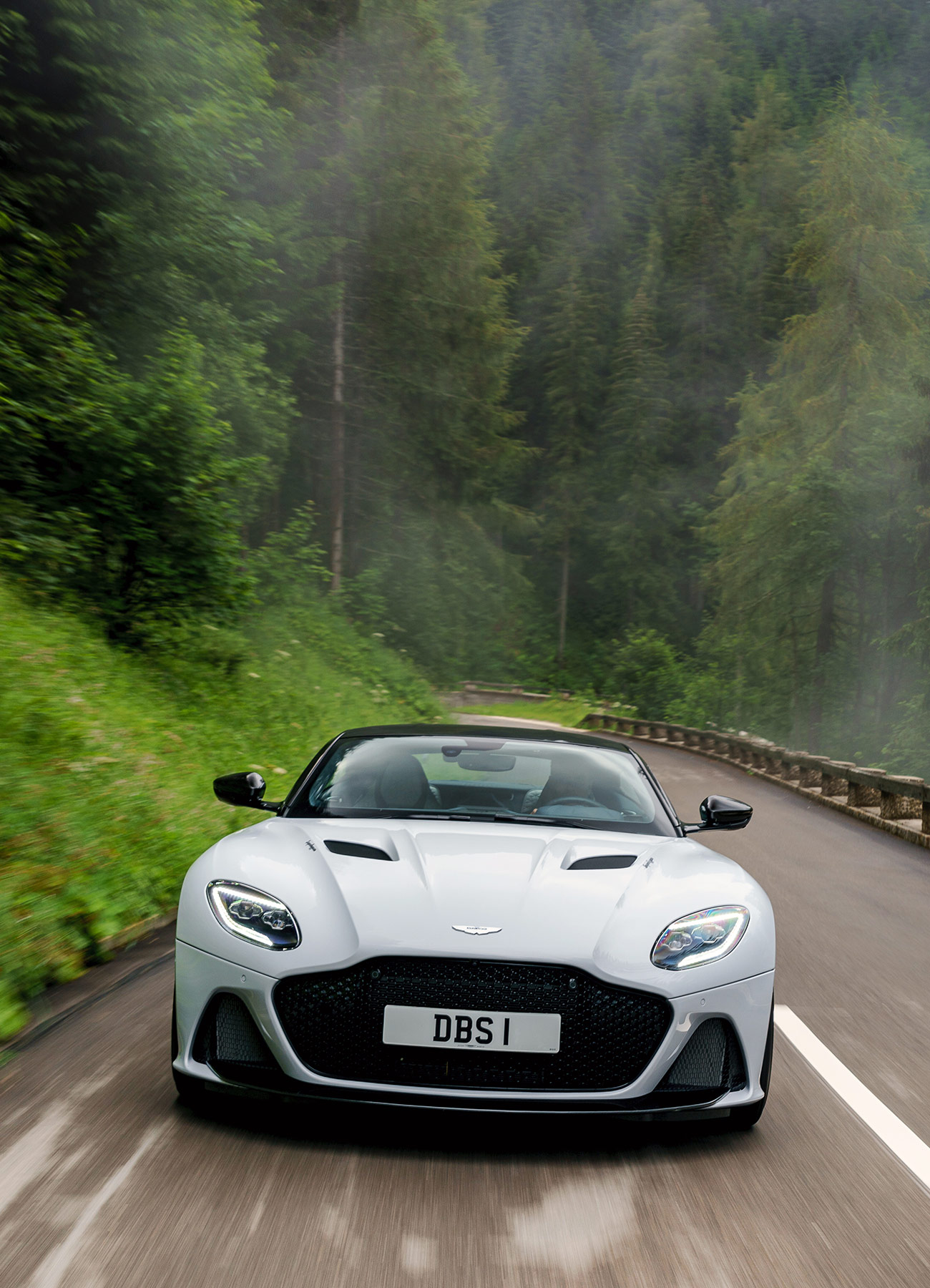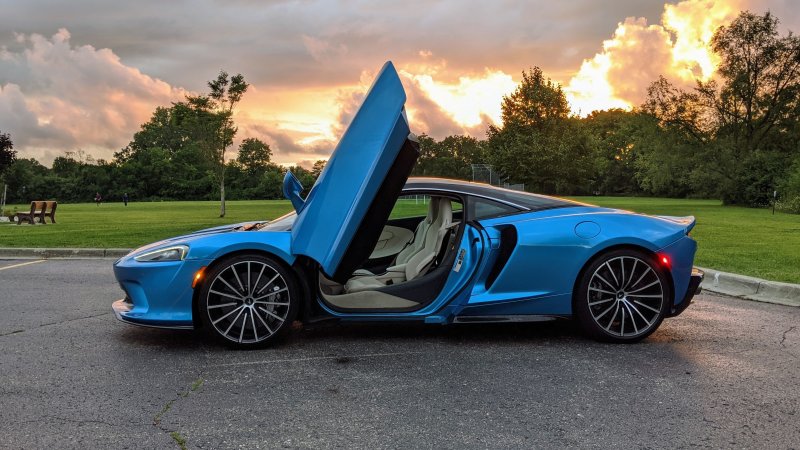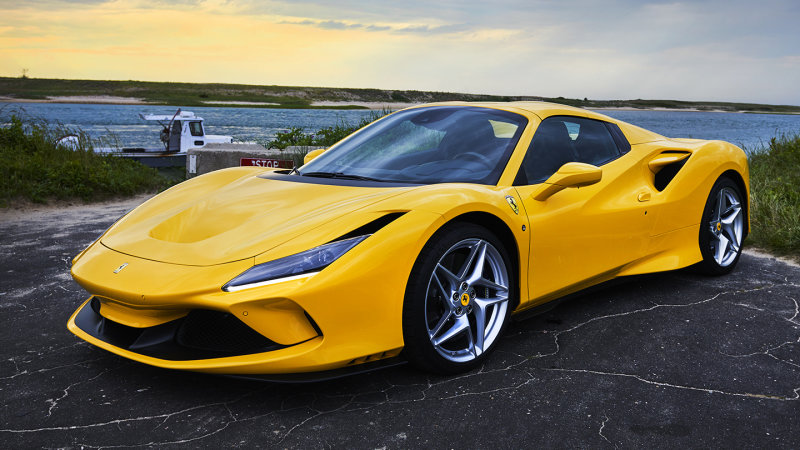Aston Martin wants the world to imagine a “brute in a suit” when first encountering the 2019 DBS Superleggera. This phrase was repeated so often ahead of our test drive in the southeast of Germany, I started to think maybe Aston was being too harsh on its own car which – excluding the arrival of the multi-million-dollar Valkyrie hypercar – now sits at the pinnacle of the company’s current model range, both in terms of price and performance.
My sympathy for the Superleggera ended once I drove this, ahem, “brute” for myself on winding roads through the German and Austrian Alps, along with some unrestricted sections of the German autobahn. As a direct replacement for the outgoing Vanquish S, Aston’s previous high-performance grand touring car, the Superleggera has gone to some pretty extreme measures to break with its past.
The Good: Having the keys to a lightweight Aston Martin, one that’s powered by a 715-horsepower, twin-turbocharged 5.2-liter V12 engine, happens to be a pretty nice way to spend an afternoon. Aston’s engineers turned up the turbo boost of the Superleggera to 1.0 bar, which is 0.3 more than what you’ll find under the hood of the DB11. You feel every bit of it, not to mention the 159 lb. drop in curb weight that’s courtesy of the Superleggera’s lighter body, which is now made entirely out of carbon fiber.
Helping feed extra air to the engine is a front-end that consists almost entirely of a giant grille and gaping brake ducts. There really isn’t much metal or, in this new era of Aston Martin, lightweight carbon fiber, found ahead of the front wheels and engine. It’s an incredibly aggressive appearance, one that might shock brand purists.
Who It’s For: This is an Aston for someone who loves the name and heritage of the brand, but yearns for something that challenges the wildest creations from the likes of Ferrari and Lamborghini. Marek Reichman, Aston Martin’s head of design and chief creative officer, said with the DBS Superleggera, the Aston brand is “showing off, finally.” I wouldn’t accuse a DB11 or the new Vantage of being demure, though there’s no doubt the DBS Superleggera represents a big step in a new direction for the English automaker.
Watch Out For: With a starting price in excess of $300,000, the DBS Superleggera is also a significant fiscal step upward from the DB11 and Vantage, not to mention rivals like the Bentley Continental GT and McLaren 570S. Does the roughly $100,000 extra you pay for this car prove worth it from the driver’s seat? The answer to this question is more complicated than comparing 0-60 mph times and top speed figures.
Alternatives: A more traditional – and some might argue, almost ubiquitous – choice in the realm of British supercars is the Bentley Continental GT. The all-new Continental GT looks and drives better than before, thanks to its gorgeous cabin, 626-horsepower W12 engine, and pavement-subduing ride quality (which is partly attributable to its nearly 5,000 lb. curb weight).
The McLaren 570S is less intent on impressing the brandy-swirling country club crowd and, like the DBS Superleggera, makes a similarly theatrical impression everywhere it goes. It doesn’t beat you up after a long drive which, to its credit, I also found holds true in the Aston. That was if you could hold on after punching the gas pedal, and trust yourself to the supercar gods – or, at the very least, Aston Martin’s engineering team.
Review: Another new Aston Martin means another round of references to James Bond, as is tradition. The overwhelming impression when behind the wheel of the DBS Superleggera is that it feels like a supercar Spectre would construct, something to beat Bond at his very own game. This is a leaner, meaner type of Aston Martin… and it takes some getting used to.
For starters, the power available from the 715-horsepower, twin-turbo V12 is absolutely unnerving, if you’re not prepared for it. Even when you think you are, this car shows a devilish side that can be equal parts awe-inspiring, and mildly terrifying. On two-lane country roads, when accelerating around slower vehicles – i.e. everything on the road other than this British supercar – flooring the gas pedal launches the car so hard, you begin to feel sorry for the asphalt that’s being wrenched apart by the 21-inch diameter, Pirelli P Zero tires at each corner.
The sound from the exhaust is just as dramatic. The stainless-steel quad exhaust system features electronic controls that respond to whichever of the three available drive modes you’ve selected: GT, Sport, and Sport Plus. In the latter two, the exhaust pops and snarls deliciously on the overrun. It’s a fantastic sound, made all the better when you can squeeze the throttle harder once unrestricted speed sections of autobahn loom ahead. If you don’t want to announce your arrival with such chest-thumping alacrity, the GT mode proves far quieter and more subdued.

With up to 400 lbs. of downforce at speed, a mechanical limited-slip differential, torque vectoring, not to mention standard carbon ceramic brakes (16.1 inches front/14.1 inches rear), it’s clear Aston didn’t forget to include important variables – like steering and stopping – into the driving mix. The most noticeable aerodynamic tweaks are located towards the rear of the car, where a small carbon fiber lip spoiler stands proud of the trunk. Below it resides an F1-inspired double diffuser that looks all business, without being too over the top. This remains an Aston Martin, after all.
That point is driven home when you’re inside the leather and Alcantara-clad cabin. Finely-quilted leather and hand-stitching are something of a given at this level of the automotive spectrum. But the DBS Superleggera still impresses with its blend of a no-nonsense layout, along with a dash of bravado provided by the heavily sculpted gauge binnacle staring at the driver. The infotainment system and most major controls are easy to understand and a significant jump forward, especially compared to Astons from only 2-3 years ago. The flat-bottomed steering wheel is a nice touch, less so are the touch-sensitive controls for audio volume. And if we’re being picky, the designation of this car as a 2+2 borders on the criminal, at least for any hapless soul squashed into one of the minuscule rear seats.
Back to the art of how this car behaves, the handling is sharp and linear, without feeling artificially weighted down by faux levels of steering ‘feel.’ You can put the DBS Superleggera exactly where you want it on the road, even if you’re not always sure where you are in relation to the outside world. Visibility towards the front of the car, particularly over and along the curvaceous hood, is a challenge. Luckily, I never heard expensive-sounding scrapes or crashes during our drive, though it might be worth getting a measuring stick if your routine parking space involves tight spaces or sudden inclines.
The double wishbone front suspension and multilink rear do an excellent job of keeping the car flat and level, without shaking you to pieces over bumpy roads. The rear suspension assembly is rubber mounted to the aluminum frame, like the DB11, to help add an extra dose of civility. Some notable tuning changes exist between the two cars, however. According to Aston Martin, the DBS Superleggera’s chassis is 10-percent stiffer than the DB11, while it’s ride height is five millimeters lower. Not dramatically different numbers, perhaps, though it all contributes to the newfound level of showmanship and performance available in this Aston.
Verdict: The DBS Superleggera proves Aston Martin likes getting wild and crazy, too. While Lamborghini and Ferrari seemingly get to redefine themselves with every new model, Aston has been beholden to a rich history that sometimes doubles as a heavy burden. An Aston has to look and drive like, well, an Aston Martin. Right?!
In many ways, the DBS Superleggera stays true to the brand’s core messages of style, desirability, and rarefied luxury. You could drive all day in GT mode and feel like a hero. But delve deeper into this car’s performance, and you’ll be surprised at how villainous the driving experience starts to feel. Brute in a suit, indeed.
What We’ve Said About the Competition:
• “The DB11 AMR is for those who understand that faster options exist but none are quite as lovely and enjoyable. This is Grand Touring, with a capital G and T” – Jeff Glucker
• “So is the GTC4Lusso actually a weird Ferrari? It does the things normal Ferraris are supposed to do: Ferraris must be fast, Ferraris must sound ethereally demonic and Ferraris must seem to endow the driver with superhuman abilities” — Nick Caruso
• “The Continental GT has been the go-to car for the affluent for so long, it’s almost too familiar in certain circles.” — Alex Kalogiannis
2019 Aston Martin DBS Superleggera Key Specs
Engine: 5.2-liter, twin-turbocharged V12
Transmission: eight-speed automatic with paddle shifters
Horsepower: 715 horsepower
Torque: 664 ft-lbs
Weight: 3,732 lbs
0-60: 3.3 seconds
Top Speed: 211 mph
Hot takes and in-depth reviews on noteworthy, relevant and interesting products. Read the Story





